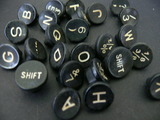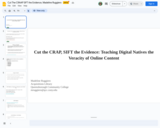
A video explaining how to add a library resources menu item in Blackboard.
- Subject:
- Education
- Material Type:
- Tutorial
- Provider:
- CUNY
- Provider Set:
- The Graduate Center
- Author:
- Mina Rees Library
- Date Added:
- 02/22/2024

A video explaining how to add a library resources menu item in Blackboard.

Tips and tools for advanced newsgathering on the web.

This Archival Research Guide includes information on archives and archival repositories, collection finding aids, conducting background research, and finding both analog and digitized collections. The guide includes links to resources, research tips, and tools for working with the sources you find.

Wikipedia is a fine place to start your research and to get a quick initial take on a subject. But to be sure you are finding the best sources on a topic and the most reliable information available, you'll want to move on to library recommended resources. Use this guide to find: print and electronic background and reference sources, subject-specific research guides, format-specific research tools, tips for effective research, and more!

On this page, we've brought together tutorials created by QCC Librarians, as well as tutorials from other libraries, addressing research and information literacy.

Welcome to the CSI Library tutorial for CC CLUE credit. The purpose of this tutorial is to introduce you to using the library's resources to locate appropriate sources for your academic papers. It was designed with ENG 111 and ENG 151 students in mind. This tutorial also teaches information literacy tools, such as avoiding plagiarism, navigating fake news, and citing your sources in MLA style. This tutorial has 5 chapters, and it should take you around 45 minutes to go through all five sections. Plan accordingly!

These tutorials allow students to access them on a variety of devices (desktop computer, tablet, phone) and integrate a variety of presentation methods (images, video, text). They also include an interactive assessment feature, so that students respond to quiz questions throughout the tutorials and get immediate feedback on their responses. Finally, these tutorials allow students to receive a certificate of completion, along with a percentage-based score. They were designed with the idea that students can retake them, either for a better grade after learning from the responsive quiz feedback, or simply to go back to features they'd like to remember in the future.

This is a research project which gives students a choice of modalities and platforms and encourages them to share their research with either the class or a wider public audience based on their interests, comfort with technology, openness, and preferences. Their focus can be: (1) answering a clearly defined research question related to the course topic, or (2) curating and writing material for a new or redesigned weekly unit plan for the course, including a detailed rationale for the unit. If students license a unit (re)design for reuse, it may make its way into a future version of the course. Image: "Typewriter Letters" by Laineys Repertoire, used under CC-BY-2.0.

Welcome to the Lehman College Library's Choose Your Own Adventure game! In this game you will need to find some important information for a friend in need. Along the way you will: Learn about the library and some of its services, Get acquainted with the library's website and resources, Be introduced to the principles of critical thinking and evaluating information.

Welcome to the Lehman College Library's Choose Your Own Adventure game! In this game you will need to find some important information for a friend in need. Along the way you will: Learn about the library and some of its services, Get acquainted with the library's website and resources, Be introduced to the principles of critical thinking and evaluating information.

A reference for current copyright law. Covers copyright materials, film music & digital media, CC/Open Access, Fair Use & current issues.

Learn to navigate court and corrections records to inform your reporting.

This activity is designed to help students formulate questions for research based on their own observations and perspective in order to encourage curiosity and authentic inquiry.

This activity helps students recognize that they need to use different types of searching language in order to retrieve relevant results and to emphasize that research is an iterative process. Note: Use when students have already formulated a research question and are about to begin searching for information on their topic.

This activity emphasizes why students need to formulate a research question in order to create effective keywords. This activity also helps students recognize that they need to use different types of searching language in order to retrieve relevant results and that research is an iterative process. Note: Use this lesson when students still need to formulate a research question.

This was a slide presentation I gave last Fall at a conference at the Grad center. I am oresenting a method of evaluating online sources by using lateral reading.

According to Project Information Literacy, defining and narrowing a topic is the most difficult step for beginning undergraduate researchers. This concept mapping activity is designed to reinforce the idea that students are creating a paper/project really entails engaging in a scholarly conversation.

This activity asks students to evaluate multiple sources in order to become more critical consumers of information.
*Note: This is a flipped classroom activity. You will need to provide students with four source types that students will evaluate as homework.

This presentation is used with students for evaluating sources. It covers the differences between popular, scholarly, and news articles. The information cycle is used to inform students about how and why topics are covered in different publications. The presentation ends with an activity where students read a snippet from a publication and are asked to guess the source.

Students will create evaluation criteria that they can use to determine the quality of a source.